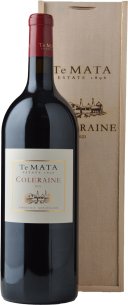Château Cos d'Estournel Saint-Estèphe
Cos d'Estournel remains today one of the true icons of Bordeaux, and the trademark of Saint Estèphe. With it's pagoda like house (as it's one of the rare Bordeaux's without a Château) it is a must visit for all travelling along the route des châteaux. Always of great reputation, the wines soared in esteem throughout the tenure of Bruno Prats through 1971 to 1998 and continue to this day with their Cabernet Sauvignon based wines of extreme purity and elegance. The 2009 vintage will be highly sought after with the conditions in the left bank region at their very best. Showing a more riper, plump fruit nature than the usual masculine, long-lived trademark, this years Cos will be quick out the door.
Château Figeac Saint-Émilion
Château Figeac is a wine estate that had a very long history. It was once part of the Cheval Blanc estate, whichs soils was well known to be two-thirds of gravel, allowing Cab Sauv, Cab Franc and Merlot to grow flourishingly in the area. The 2010 Figeac, had a beautiful complexity to enjoy now or the longevity to cellar for those who prefers. Wine will benefit from decanting.
Chateau Palmer 3me cru classe
Regarded a Super Second (but technically a 3me growth), Palmer is capable of producing wines that equal or even outstrip the quality of its famous Premier cru neighbour, Ch. Margaux. Named for the wealthy English military man who bought the estate in the early 19th century, Palmer is now majority owned by the Mahler Besse and Sichel families - famous Bordeaux negociants. Many of the best plots on the property were purchased after the Classification of 1855, explaining in part why Palmer did not warrant higher standing at that time. Certainly today there is no question that the wine is among Bordeauxs best. The estate also makes a separate second label - named Alter Ego - which is made from similarly high quality fruit but treated differently in the winery with the aim of producing a counterpoint in style to the First wine.
Château la Fleur Pétrus Pomerol
Château La Fleur Pétrus is a Cabernet Sauvignon dominant red blend. Vintage 2010 has the great balance between the intensity of the fruits, acidity and oak flavour. Ripe black fruits and jammy cherries with a hint of meaty back tone. Full body with pronounced tannins, elegantly put together. Perfect for those who love to cellar their reds.
Château Lynch-Bages Pauillac
While it is true that lovers of Pauillac wines can sometimes be divided over their love of the wines from Lynch-Bages, it will go without question that the wines produced from the magnificent 2009 vintage are sure to be coveted by all. Vintage conditions were simply perfect and have allow this Pauillac producer to embrace its love of plush, fruit forward wines and yet deliver a wine of immense power and structure.
Château Cos D'Estournel St-Estèphe
In the upper echelon of 2nd Growth estates, Chateau Cos D''Estournel is located in St-Estephe appelltion, on the fringe of Paulliac and notably just north of the famed Lafite vineyards. Tourists flock to the Medoc estate to see the unusual, Asian-inspired Chateau design, but the wines hold their own and rightfully are considered the finest within St-Estephe. Oak is set to around 80% new barrels while alcohol is a modest 14.5%; the blend in 2010 is 78% Cabernet Sauvignon with 19% Merlot and complimentary Cabernet Franc and Petit Verdot in tow. A wine for thirty or so years.
Te Mata Estate Coleraine Cabernet Sauvignon Merlot Cabernet Franc
TE MATA ESTATE Coleraine. Cepage may include Cabernet Sauvignon, Merlot, and Cabernet Franc. Hawkes Bay, New Zealand
Château Palmer Margaux
Château Palmer is considered one of the worlds first 'Super Seconds' (although actually classified as a third growth), a term relating to the top echelon of producers that fall outside of the ancient 1st Growth classification. Margaux's Château Palmer was named after a British general who fought under Wellington. It has been stated by quite a few wine critics that this could possibly be the finest Château Palmer ever produced. An amazing claim considering how phenomenal the 2005 was and is yet to be. Masses of concentrated aromas and flavours that will keep your senses entertained for hours on end. A truly remarkable achievement that will repay the patient cellarer over the next 30 years.
Chateau Phelan-Segur
Pavillon Rouge du Château Margaux
The wine comes with the tag of ''second wine'' from the esteemed Chateau Margaux, though it''s made with the intent to stand on its own two feet. The blend tends to sit around two thirds Cabernet Sauvignon and one third Merlot, but a seasoning of Petit Verdot and Cabernet Franc is essential for the fine detail of perfume and flavours expected from this wine. 2010 sees a wine of grace and purity - it''s fruit dominant and supple, fleshy and ample, cuddly and almost nourishing to drink. A wine for admiring and comparing to its great parent too.






























